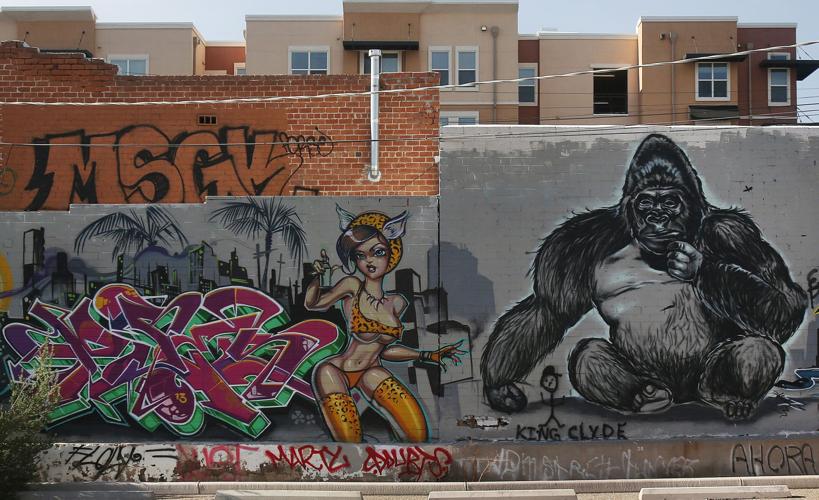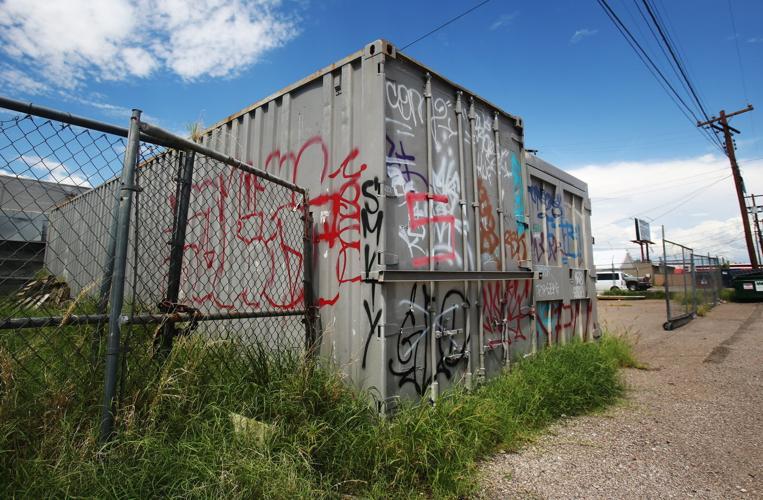Each year Tucsonans spend more than $1 million removing graffiti like the spray-painted scrawls that recently defaced the Fox Theatre downtown.
But other communities have found success with programs that prevent graffiti rather than paint over it — and local supporters say Tucson could do the same.
Options like graffiti walls or mural projects could provide a productive outlet for taggers, said Michael B. Schwartz, director of the Tucson Arts Brigade, an after-school program that organizes mural projects around town. Schwartz said the feedback he gets from communities that participate in mural programs is always the same.
“It was inspiring people and had kind of a ripple effect,” he said. “People love the arts and love anything that brings the community together.”
Supporters say public support of such efforts could cut or eliminate the amount spent on graffiti abatement: The city’s Transportation Department alone issued more than 62,000 work orders last fiscal year and paid a contractor $720,000 to paint over all the tags. And that’s in addition to abatement by power and phone companies, which are responsible for graffiti on their utility boxes.
Spending money on mural projects, which have proven to reduce tagging, is a better investment than increasing enforcement, Tucson City Councilman Steve Kozachik said.
“Everyone’s paying for it, over and over,” Kozachik said. “If we can reduce the area that’s being tagged right now, and you’re not going back next month and abating again, we’re saving money in the long run,” he said. “Plus, the city will look nicer.”
Here are some graffiti prevention ideas that have proven to work here and elsewhere:
Legal graffiti walls
The historic Venice Pavilion in Venice, California, was a magnet for taggers.
But since 1999, after the city tore down most of the pavilion, the remains have offered a legal alternative to the formerly illegal behavior. Venice Art Walls offers graffiti writers a place to paint and tag, with their creations curated by local graffiti production company Setting the Pace.
The Setting the Pace foundation began managing the Venice Art Walls in 2012, and the group has since organized mural workshops for students and young artists.
Bruno Hernandez, executive director at Setting the Pace, said becoming a mentor for young people interested in graffiti art was a major motivation for spearheading the nonprofit organization.
“It really is important to have legitimate role models,” Hernandez said.
Setting the Pace uses the planning of mural projects as a metaphor for achieving long-term life goals for the students and young people who participate.
When a school district is faced with a budget deficit, art classes are the first to be cut, Hernandez said. And for students who do not excel in academics, a creative outlet like art may be what’s keeping them in school, he added.
Artists interested in painting at the Venice Art Walls must follow strict guidelines.
For instance, painting is allowed only on weekends, minors can paint only with brushes or paint rollers, and all artists must have a permit.
Hernandez said he doesn’t want another generation risking the many setbacks of illegal graffiti writing such as gang affiliation, violence, incarceration and the overall negativity tagging creates within the community.
Also, having a safe and legal place to express themselves helps prevent run-ins if taggers drift into another crew’s territory, Hernandez said.
Utility box murals
A mural program in San Diego turns public utility boxes into sanctioned art spaces.
Kozachik said he is working with local utility companies to launch a similar program here.
Not only could it improve urban aesthetics, it could save customers money, he said.
Taggers are more likely to deface blank walls, utility boxes or traffic control hardware, the Tucson graffiti task force says. They typically avoid defacing legitimate artwork or murals.
Private energy companies have been reluctant to agree to a mural program so far, but the Tucson Transportation and Environmental Services departments are on board, Kozachik said. He said if the program is successful, he hopes the private sector will follow suit.
“Let’s get the city to lead by example,” Kozachik said.
large-scale murals
The Tucson Arts Brigade was formed in 1995 to introduce the creative arts in Tucson’s low-income schools.
At the time, the city had many more arts organizations because of regular funding, so the Brigade focused on its City Wide After School Arts & Civic Engagement Program, Schwartz said.
During the past 20 years, it has organized multiple large-scale mural art projects throughout Tucson, including the Amphi Community Action Mural Project, the 29th Street Community Mural Project and the Together We Thrive Mural at 316 N. Fourth Ave.
From 2009 to 2013, communities that participated in one of the organization’s mural programs saw nearby graffiti decline at least 69 percent, Schwartz said.
This year, the organization is set to paint five trash containers at Tucson’s Environmental Services Center. It is negotiating with the Washington, D.C.-based Graffiti Resource Council to match the $5,000 of local funding.
Schwartz said many smaller cities throughout the U.S. have embraced programs like the utility box mural proposal. Not only do the projects employ local artists, but their respective neighborhoods also benefit, he said.
As long as Tucson makes abatement a higher priority than prevention, groups like the Tucson Arts Brigade will falter, Schwartz said. His only project at the moment is the trash containers, and he is looking outside Tucson for matching funds. He has no employees and says staying afloat is a constant challenge.
“The traditional forms of funding that we got used to, or that kept our work going in the field, have evaporated,” he said.
If projects like the utility box program take off, he said, Tucson’s arts community could thrive — and so could its economy.
“Cities that have embraced not just the arts, but the creative economy as a whole, tend to be doing a little bit better these days,” he said. “The idea is to support our local artists, pay them well, and keep them in Tucson.”







